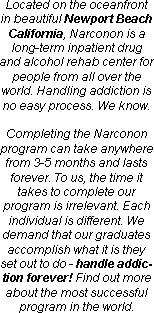
|
Navigate |
| Home |
| Kirstie Alley |
| Our 30th Anniversary |
| Never Turning Back |
| Narconon Endorsements |
| |
|
|
| |
|
|
| |
|
Facts About Drugs |
| FAQ About Ambien |
| FAQ About Ativan |
| FAQ About Cocaine |
| FAQ About Codeine |
| FAQ About Crack |
| FAQ About Darvocet |
| FAQ About Dexedrine |
| FAQ About Demerol |
| FAQ About Dilaudid |
| FAQ About Ecstasy |
| FAQ About GHB |
| FAQ About Heroin |
| FAQ About Hydrocodone |
| FAQ About Ketamine |
| FAQ About Lortab |
| FAQ About LSD |
| FAQ About Marijuana |
| FAQ About Morphine |
| FAQ About Meth |
| FAQ About Methadone |
| FAQ About Opiates |
| FAQ About Opium |
| FAQ About Oxycontin |
| FAQ About Percocet |
| FAQ About Percodan |
| FAQ About Ritalin |
| FAQ About Rohypnol |
| FAQ About Ultram |
| FAQ About Valium |
| FAQ About Vicodin |
| FAQ About Xanax |
  |
|
Resources |

|


 Print this article |  Send this article to a friend |  Add to Favorites |
Summary Data
Appendix: Summaries of Published Papers Regarding the Hubbard Detoxification Method
Evaluation of a Detoxification Regimen for Fat Stored Xenobiotics Medical Hypothesis, Vol.9, 1982
Summary: One hundred and three individuals undergoing detoxification with the Hubbard procedure volunteered to undergo additional physical and psychological tests concomitant with the program. Participants had been exposed to recreational (abused) and medical drugs, patent medicines, occupational and environmental chemicals. Patients with high blood pressure had a mean reduction of 30.8 mm systolic, 23.3 mm diastolic; cholesterol level mean reduction was 19.5 mg/ 100 ml, while triglycerides did not change. Completion of the detoxification program also resulted in improvements in psychological test scores, with a mean increase in Wechsler Adult Intelligence Scale IQ of 6.7 points. Scores on Minnesota Multiphasic Personality Inventory profiles decreased on Scales (4-7) where high scores are associated with amoral and asocial personalities, psychopathic behavior and paranoia. Medical complications resulting from detoxification were rare, occurring in less than three percent of the subjects.
Body Burden Reductions of PCBs, PBBs and Chlorinated Pesticide Residues in Human Subjects
Ambio, Vol.13, No.5-6, 1984.
Summary: Prior to detoxification, adipose tissue concentrations were determined for seven individuals accidentally exposed to PBBs. The chemicals targeted for analysis included the major congeners of PBBs, PCBs and the residues of common chlorinated insecticides. Of the 16 organohalides examined, 13 were present in lower concentrations following detoxification. Seven of the 3 reductions were statistically significant; reductions ranged from 3.5 to 47.2 percent, with a mean reduction among the 16 chemicals of 21.3 percent (s.d. 17.1 percent). To determine whether reductions reflected movement to other body compartments or actual burden reduction, a post-treatment follow-up sample was taken four months later. Follow-up analysis showed a reduction in all 16 chemicals averaging 42.4 percent (s.d. 17.1 percent) and ranging from 10.1 to 65.9 percent. Ten of the 16 reductions were statistically significant.
Diagnosis and Treatment of Patients Presenting Sub-clinical Signs and Symptoms of Exposure to Chemicals Which Accumulate in Human Tissue
Proceedings of the National Conference on Hazardous Wastes and Environmental Emergencies, Cincinnati, Ohio, 1985.
Summary: A discussion of some of the problems in attempting to diagnose and treat low-level body burdens of toxic chemicals. A review of 120 patients who were prescribed detoxification treatment as developed by Hubbard to eliminate fat-stored compounds showed improvement in 14 of 15 symptoms associated with several types of chemical exposures.
Reduction of the Human Body Burdens of Hexachlorobenzene and Polychlorinated Biphenyls
World Health Organization, International Agency for Research on Cancer, Scientific Publications Series, Volume 77, 1986.
Summary: Electrical workers paired by age, sex and potential for polychlorinated biphenyl exposure were divided into treatment and control groups. Adipose-tissue concentrations of hexachlorobenzene (HCB), four other pesticides and 10 polychlorinated biphenyl congeners were determined pre- and post-treatment, and three months post-treatment. At post-treatment, all 16 chemicals were found at lower concentrations in the adipose tissues of the treatment group, while 11 were found in higher concentrations in the control group. Adjusted for re-exposure as represented in the control group, HCB concentrations were reduced by 30 percent at post-treatment and 28 percent three months post-treatment. Mean reduction of polychlorinated biphenyl congeners was 61 percent at post-treatment and 14 percent three months post-treatment. These reductions are statistically significant (f< 0.001). Enhanced excretion appeared to keep pace with mobilization, as blood-serum levels in the treatment group did not increase during treatment.
Excretion of a Lipophilic Toxicant Through the Sebaceous Glands: A Case Report
Journal of Toxicology Cutaneous and Ocular Toxicology, Vol. 6, No. 1, 1987.
Summary: A 23-year-old woman worked at a manufacturing facility, hosing the soot and ash accumulated in the exhaust stack and on the filter pads of an oil-fired generator. She performed this task without protective gear. After six months, she reported feeling ill to the plant nurse. One month later, she was removed from the job, and she remained unable to work for 11 1/2 months because of symptoms relating to toxic chemical exposure. The toxicants were amenable to removal through the sebaceous glands and possibly the gastrointestinal tract by the Hubbard detoxification technique. This was accompanied by remission of her subjective complaints and she was authorized to return to work.
Improvement in Perception of Transcutaneous Nerve Stimulation Following Detoxification in Firefighters Exposed to PCBs, PCDDs and PCDFs
Clinical Ecology, Vol. VI, No.2, 1989.
Summary: Seventeen firefighters with a history of acute exposure to polychlorinated biphyenyls, dibenzofurans, and dibenzodioxins were evaluated for peripheral neuropathy. Neuropathic evaluation was done using the Neurometer®, a transcutaneous nerve stimulation device. Prior to detoxification, five of the 17 had abnormal current perception threshold measurements. Following treatment, all showed improvement. Most strikingly, the current perception thresholds of two patients returned to normal range after detoxification. This finding raises the possibility that damage heretofore thought to be permanent may in many instances be partially reversible.
Occupational, Environmental and Public Health in Semic: A Case Study of Polychlorinated Biphenyl (PCB) Pollution
Proceedings of the Annual Meeting of the American Society of Civil Engineers, New Orleans, Louisiana, October, 1989.
Summary: Eleven workers with readily observable symptoms of exposure to PCBs and other chemicals were chosen for detoxification from a group of 24 male volunteers from a factory using PCBs in the manufacture of capacitors. The remaining 13 served as a control group. Detoxification treatment reduced both the body burdens and the symptoms of treated workers while no such improvements occurred in the control group. This study, undertaken in cooperation with the University Medical Center of Ljubljana and the Institute for Toxicology, University and Technical Faculty of Zurich, supports the use of health screening and detoxification for individuals affected by toxic exposures.
Human Contamination and Detoxification: Medical Response to an Expanding Global Problem
Proceedings of the MAB UNESCO Task Force on Human Response to Environmental Stress, Moscow, 1989.
Summary: Individuals with a variety of workplace exposures were unable to work or had reduced work capacity. Following detoxification, each was able to return to work. Though the results presented are anecdotal, they confirm previous findings in the peer-reviewed literature (Schnare et al., 1982; Roehm, 1983; Schnare et al., 1984; Schnare and Robinson, 1985; Tretjak et al., 1989) and demonstrate that this approach can be effective in reducing body burdens of toxic compounds and returning individuals to the workplace.
Neurobehavioral Dysfunction in Firemen Exposed to Polychlorinated Biphenyls (PCBs): Possible Improvement after Detoxification.
Archives of Environmental Health, Vol.44, No. 6, 1989.
Summary: Fourteen firemen were exposed to polychlorinated biphenyls (PCBs) and their by-products at the site of a transformer fire and explosion. Six months after the fire, they underwent neurophysiological and neuropsychological tests. They were re-studied six weeks after detoxification. A control group of firefighters was selected from firemen who resided in the same city but were not engaged in the fire in question. Initial testing showed that firemen exposed to PCBs had poorer neurobehavioral function than the control group. Significant reversibility of impairment was noted after detoxification.
PCB Reduction and Clinical Improvement by Detoxification: An Unexploited Approach?
Human and Experimental Toxicology, Vol.9, 1991.
Summary: A female worker from a capacitor factory, with a history of exposure to polychlorinated biphenyls (PCBs) and other lipophilic industrial chemicals, was admitted for treatment at the University Medical Centre of Ljubljana, Slovenia (then Yugoslavia). She presented with severe abdominal complaints, chloracne, liver abnormalities and a bluish-green nipple discharge of approximately 50 ml in quantity. High PCB levels were noted in adipose tissue (102 mg kg'), serum (512 ug/1'), skin lipids (66.3 mg kg'), and in the nipple discharge (712 ug 1'). After detoxification, PCB levels in adipose tissue were reduced to 37.4 mg kg' and in serum to 261 ug', respective reductions of 63 percent and 49 percent. Excretion of intact PCBs in serum, appreciable before treatment, was enhanced by up to five-fold during detoxification. The nipple discharge ceased early in the detoxification regimen.
Xenobiotic Reduction and Clinical Improvements in Capacitor
Workers: A Feasible Method
Journal of Environmental Science and Health,
Vol. A25, No.7,1990.
Summary: Eleven capacitor workers, occupationally exposed to PCBs and other industrial chemicals, underwent detoxification. Thirteen co-workers served as controls. Mean PCB levels prior to detoxification were 28.0 mg/kg in adipose and 188.0 ug/L in serum. Following detoxification, PCBs were reduced in serum by 42 percent (p<0.05) and in adipose by 30 percent for patients without concurrent disease. Patients with concurrent disease had a 10 percent reduction in adipose levels, while serum levels remained unchanged. Both adipose and serum PCB levels increased in members of the control group. At a four-month follow up examination, these differences were maintained, though the mean adipose PCB values in all groups were higher than at post-treatment. All patients reported marked improvement in clinical symptoms post-treatment, with most of these improvements retained at follow-up. No such improvements were noted in controls.
Treatment of Pesticide-Exposed Patients with the Hubbard Method of Detoxification.
Presentation at the 120th Annual Meeting of the American Public Health Association, 1992.
Summary: A review of the efficacy of detoxification in addressing the complaints of 155 patients who had experienced significant exposures to pesticides. Treatment effected reductions in chemical levels in adipose tissue, and a concomitant decrease in symptomatic complaints.
Neurotoxicity and Toxic Body Burdens: Relationship and Treatment Potentials
Proceedings of the International Conference on Peripheral Nerve Toxicity, 1993.
Summary: Many chemicals have neurotoxic health effects of long duration, leading to the conclusion that these effects are essentially irreversible. This paper proposes that the accumulation and persistence of neurotoxic chemicals in adipose tissue may play a role in the prolongation of neurotoxic effects. If this were the case, an approach designed to reduce body burdens of fat-soluble compounds should lead to a similar reduction in neurotoxic effects. Transcutaneous current perception thresholds were measured using the Neurometer device in 48 patients exhibiting neurotoxic effects both before and after detoxification. Following detoxification, marked improvements were noted in both peripheral neuropathy and self-reported patient profiles.
Reduction of Drug Residues: Applications in Drug Rehabilitation
Presentation at the 123rd Annual Meeting of the American Public Health Association, 1995
Summary: Drug residues and their lipophilic metabolites are associated with persistent symptoms; their mobilization into blood correlates with drug cravings. The concentration of drug metabolites in both sweat and urine was measured in eight individuals who had been actively using drugs prior to detoxification. Cocaine, opiate, and benzodiazepine metabolites were detected by fluorescent immunoassay in both sweat and urine. Low levels (not indicative of use) continued to be eliminated for several weeks. In two cases, drug levels were below detection prior to treatment but became detectable during detoxification. A separate series of 249 clients with a history of drug abuse rated the severity of their symptoms before and after detoxification. Chief symptomatic complaints prior to detoxification included fatigue, irritability, depression, intolerance of stress, reduced attention span and decreased mental acuity. (These same symptoms were dominant in those who had ceased active drug abuse over a year prior to treatment.) Following detoxification, both past and current users reported marked improvements in symptoms, with most returning to normal range.
Treatment of Children with the Detoxification Method Developed by Hubbard
Presentation at the 123rd Annual Meeting of the American Public Health Association, 1995
Summary: Eighteen children from ten families were referred for detoxification. Their chief complaints included environmental sensitivity, headaches, chronic fatigue, allergies, respiratory problems and recurrent infections. In each case, the entire family had become ill following a known change (e.g., application of pesticides, installation of improperly cured carpet) in their environment. The ages of the children ranged from neonatal to 15 at the time of exposure, with treatment ages ranging from 4 to 21. Treatment resulted in improvements in symptom profiles, with at least 89 percent of the children reporting long-term improvements in their symptoms.
Precipitation of Cocaine Metabolites in Sweat and Urine of Addicts Undergoing Sauna Bath Treatment
Fifty-Seventh Annual Scientific Meeting, National Institute on Drug Abuse, College on Problems of Drug Dependency, 1995
Summary: Four subjects (three males and one female) admitted to a residential treatment program were selected for study. All met DSM-III-R Criteria for cocaine dependence and ingested cocaine by smoking. The duration of their use of the drug ranged from eight months to 18 years, and they reported cocaine use on over 75 percent of days in the month just prior to treatment. Three reported last use of cocaine within 48 hours of admission; one reported last use 25 days prior to program entry. Urine and sweat samples were collected from subjects every two to three days during detoxification and analyzed by fluorescent immunoassay. Cocaine metabolites were detectable in both sweat and urine of all subjects. Three of the four subjects showed a measurable increase in sweat or urine cocaine metabolite concentrations at the beginning of detoxification. Two subjects demonstrated negative urine samples prior to detoxification, but demonstrated the presence of metabolites when detoxification commenced.
Reduction of the Radioisotope Cs-137 Using the Detoxification Method Developed by Hubbard
Presentation at the 124th Annual Meeting of the American Public Health Associations, 1996.
Summary: Fourteen children living in the plume path of the destroyed Chernobyl reactor underwent detoxification. Each was periodically measured using a portable radiation detection system capable of measuring the characteristic gamma ray emitted during the radioactive decay of Cs-137. (Five such measures were made over the course of approximately four weeks.) Elimination rates were compared to expected rates of elimination from published studies. Children uniformly eliminated Cs-137 more rapidly than expected, with the exception of two cases in which children were eating contaminated treats from home. (Rapid elimination of Cs-137 resumed when these items were eliminated from their diets.)

comment corner
 |
| drug rehabilitation saving taxpayers |
California taxpayers are saving more money than expected due to ... |
 |
| Study: Marijuana Causes Lung Damage |
New research finds that smoking three or four marijuana cigarettes ... |
 |
| Thanks to Online Pharmacies, Addiction Can Be Just a Click Away |
WASHINGTON -- Kelly Knable, a 34-year-old mother of three from ... |
 |
| Balancing pain and drug addiction |
Over the past two decades, two conflicting medical ideas have ... |
 |
| Clean break |
... |
 |
| State officials create prescription drug abuse task force |
TALLAHASSEE, Fla. -- State officials on Friday announced the creation ... |
 |
| Florida system often fails to catch Medicaid abuse at source |
FORT LAUDERDALE, Fla. - (KRT) - The victim's skin was ... |
 |
| Marijuana's rising threat: For more kids, use turns into addiction |
John Brown experimented with marijuana at age 10, and it ... |
 |
| Student gets state prison term for selling marijuana |
EASTON -- David Messina had his whole life ahead of ... |
 |
| Man charged in cocaine case forfeits $585,000 |
An Iowa truck driver arrested by Kentucky Vehicle Enforcement officers ... |
 |
| Cocaine Curtails Body's Ability to Cool Off |
In addition to triggering life-threatening cardiovascular episodes, cocaine can be ... |
 |
| Science for Cops |
I admit it: I'm a Law & Order fan. ... |
 |
| New Gene Therapy Could Help Quell Alcoholic Cravings |
One prevailing view of addiction holds that alcohol and other ... |
 |
| One Dose of Cocaine Primes the Brain for Addiction |
It isn't a myth: one dose of cocaine is all ... |
 |
| Marijuana Firmly Linked to Infertility |
Scientists from the University of Buffalo have smoked out what ... |
 |
| Moderate Alcohol Consumption Clouds Brain's Ability to Detect Mistakes |
It's common knowledge that a brain on booze doesn't function ... |
|
Narconon Pictures |
|
   |
|